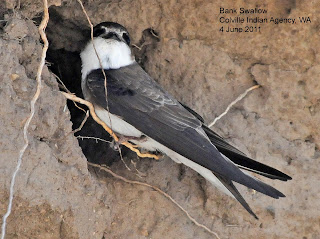Finally, a swallow that nests only where it is supposed to.
Bank Swallows (Riparia riparia) nest
in sand banks, usually in colonies, sometimes in very large colonies. These vertical
or near-vertical banks are typically along rivers but may be in dry areas as
well, even sand quarries and piles of sand thrown up by construction and then
abandoned. Thus like all other swallows, their nest sites can be augmented by
human activities.
Bank Swallows are common breeding birds across northern
North America. They winter mostly in South America and are common migrants in
between. Breeding also all across Eurasia, they are one of the most widely
distributed songbirds (like the Barn Swallow).
Bank Swallow colonies range from just a few birds to up to
1,500 active nests. The burrows can be quite near to one another but stretch
for hundreds of feet along a bank.
At new sites, males begin excavating burrows as pairs are
forming. A male with a burrow will fly after a female and attempt to attract
her to the burrow, where he lands at the opening. If she is interested, she
will accompany him inside, where copulation takes place.
Although Bank Swallows are socially monogamous, males
constantly attempt extra-pair copulations. When a female leaves the nest, her
mate often flies right on her tail to keep other males from attempted mating,
and this is successful most of the time. These flights, usually with three or
more birds, can be seen constantly around colonies early in the season. One
researcher found that males could actually distinguish heavier females,
apparently receptive to breeding, and preferentially chase them.
The burrow is dug with beak, feet and wings. The excavation
takes about 4 or 5 days, and then the female begins to gather material for the
nest at the end of the burrow, taking another few days. The four or five eggs
are laid one each day, and incubation, mostly by the female, ensues for about
two weeks after the last egg is laid.
Both adults gather food for the brood, and it has been
estimated they bring about 60 prey items/visit and feed the entire brood about
7,000 insects in total. If you're worried about bugs, it would seem to pay to
live near a Bank Swallow colony. 500 nests x 7,000 insects = 3.5 million fewer
insects in three weeks! But what would the Society for the Prevention of
Cruelty to Insects say about that?
The young leave the nest at about three weeks of age and
gather in communal perching areas, where they are fed for up to another week.
Adults recognize their own young vocally among the clamoring of many
individuals, much like the case in a tern or gull or penguin colony.
Dennis Paulson















